Chengrui Gao
Open3DBench: Open-Source Benchmark for 3D-IC Backend Implementation and PPA Evaluation
Mar 17, 2025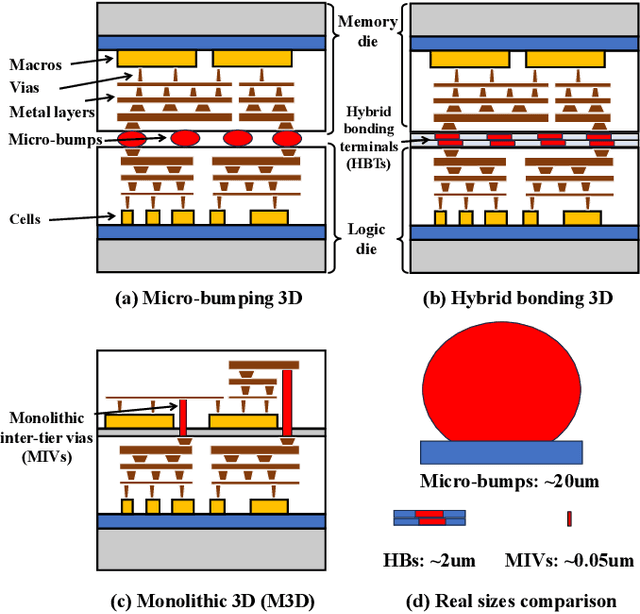
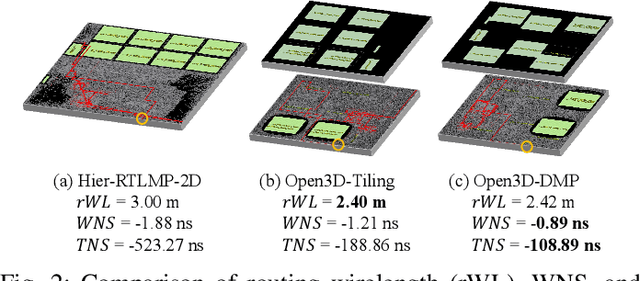
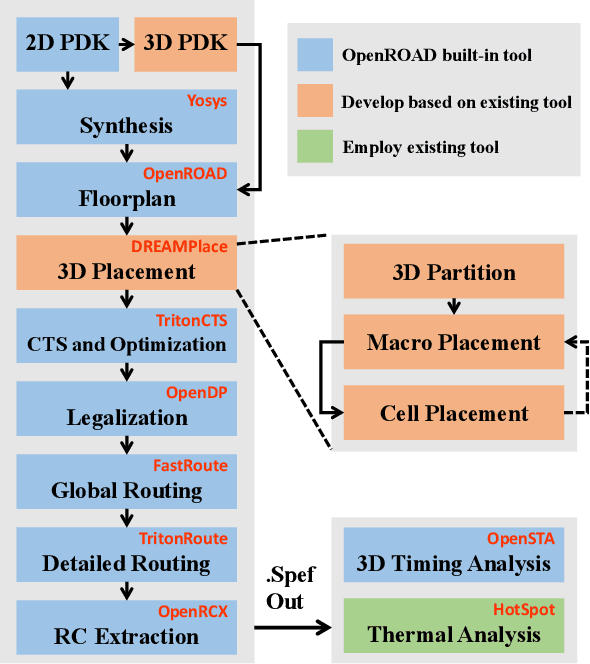

Abstract:This work introduces Open3DBench, an open-source 3D-IC backend implementation benchmark built upon the OpenROAD-flow-scripts framework, enabling comprehensive evaluation of power, performance, area, and thermal metrics. Our proposed flow supports modular integration of 3D partitioning, placement, 3D routing, RC extraction, and thermal simulation, aligning with advanced 3D flows that rely on commercial tools and in-house scripts. We present two foundational 3D placement algorithms: Open3D-Tiling, which emphasizes regular macro placement, and Open3D-DMP, which enhances wirelength optimization through cross-die co-placement with analytical placer DREAMPlace. Experimental results show significant improvements in area (51.19%), wirelength (24.06%), timing (30.84%), and power (5.72%) compared to 2D flows. The results also highlight that better wirelength does not necessarily lead to PPA gain, emphasizing the need of developing PPA-driven methods. Open3DBench offers a standardized, reproducible platform for evaluating 3D EDA methods, effectively bridging the gap between open-source tools and commercial solutions in 3D-IC design.
FedPalm: A General Federated Learning Framework for Closed- and Open-Set Palmprint Verification
Mar 05, 2025



Abstract:Current deep learning (DL)-based palmprint verification models rely on centralized training with large datasets, which raises significant privacy concerns due to biometric data's sensitive and immutable nature. Federated learning~(FL), a privacy-preserving distributed learning paradigm, offers a compelling alternative by enabling collaborative model training without the need for data sharing. However, FL-based palmprint verification faces critical challenges, including data heterogeneity from diverse identities and the absence of standardized evaluation benchmarks. This paper addresses these gaps by establishing a comprehensive benchmark for FL-based palmprint verification, which explicitly defines and evaluates two practical scenarios: closed-set and open-set verification. We propose FedPalm, a unified FL framework that balances local adaptability with global generalization. Each client trains a personalized textural expert tailored to local data and collaboratively contributes to a shared global textural expert for extracting generalized features. To further enhance verification performance, we introduce a Textural Expert Interaction Module that dynamically routes textural features among experts to generate refined side textural features. Learnable parameters are employed to model relationships between original and side features, fostering cross-texture-expert interaction and improving feature discrimination. Extensive experiments validate the effectiveness of FedPalm, demonstrating robust performance across both scenarios and providing a promising foundation for advancing FL-based palmprint verification research.
Pareto Set Learning for Multi-Objective Reinforcement Learning
Jan 14, 2025Abstract:Multi-objective decision-making problems have emerged in numerous real-world scenarios, such as video games, navigation and robotics. Considering the clear advantages of Reinforcement Learning (RL) in optimizing decision-making processes, researchers have delved into the development of Multi-Objective RL (MORL) methods for solving multi-objective decision problems. However, previous methods either cannot obtain the entire Pareto front, or employ only a single policy network for all the preferences over multiple objectives, which may not produce personalized solutions for each preference. To address these limitations, we propose a novel decomposition-based framework for MORL, Pareto Set Learning for MORL (PSL-MORL), that harnesses the generation capability of hypernetwork to produce the parameters of the policy network for each decomposition weight, generating relatively distinct policies for various scalarized subproblems with high efficiency. PSL-MORL is a general framework, which is compatible for any RL algorithm. The theoretical result guarantees the superiority of the model capacity of PSL-MORL and the optimality of the obtained policy network. Through extensive experiments on diverse benchmarks, we demonstrate the effectiveness of PSL-MORL in achieving dense coverage of the Pareto front, significantly outperforming state-of-the-art MORL methods in the hypervolume and sparsity indicators.
Deep Learning in Palmprint Recognition-A Comprehensive Survey
Jan 02, 2025



Abstract:Palmprint recognition has emerged as a prominent biometric technology, widely applied in diverse scenarios. Traditional handcrafted methods for palmprint recognition often fall short in representation capability, as they heavily depend on researchers' prior knowledge. Deep learning (DL) has been introduced to address this limitation, leveraging its remarkable successes across various domains. While existing surveys focus narrowly on specific tasks within palmprint recognition-often grounded in traditional methodologies-there remains a significant gap in comprehensive research exploring DL-based approaches across all facets of palmprint recognition. This paper bridges that gap by thoroughly reviewing recent advancements in DL-powered palmprint recognition. The paper systematically examines progress across key tasks, including region-of-interest segmentation, feature extraction, and security/privacy-oriented challenges. Beyond highlighting these advancements, the paper identifies current challenges and uncovers promising opportunities for future research. By consolidating state-of-the-art progress, this review serves as a valuable resource for researchers, enabling them to stay abreast of cutting-edge technologies and drive innovation in palmprint recognition.
Neural Solver Selection for Combinatorial Optimization
Oct 13, 2024



Abstract:Machine learning has increasingly been employed to solve NP-hard combinatorial optimization problems, resulting in the emergence of neural solvers that demonstrate remarkable performance, even with minimal domain-specific knowledge. To date, the community has created numerous open-source neural solvers with distinct motivations and inductive biases. While considerable efforts are devoted to designing powerful single solvers, our findings reveal that existing solvers typically demonstrate complementary performance across different problem instances. This suggests that significant improvements could be achieved through effective coordination of neural solvers at the instance level. In this work, we propose the first general framework to coordinate the neural solvers, which involves feature extraction, selection model, and selection strategy, aiming to allocate each instance to the most suitable solvers. To instantiate, we collect several typical neural solvers with state-of-the-art performance as alternatives, and explore various methods for each component of the framework. We evaluated our framework on two extensively studied combinatorial optimization problems, Traveling Salesman Problem (TSP) and Capacitated Vehicle Routing Problem (CVRP). Experimental results show that the proposed framework can effectively distribute instances and the resulting composite solver can achieve significantly better performance (e.g., reduce the optimality gap by 0.88\% on TSPLIB and 0.71\% on CVRPLIB) than the best individual neural solver with little extra time cost.
Beyond First-Order: A Multi-Scale Approach to Finger Knuckle Print Biometrics
Jun 28, 2024Abstract:Recently, finger knuckle prints (FKPs) have gained attention due to their rich textural patterns, positioning them as a promising biometric for identity recognition. Prior FKP recognition methods predominantly leverage first-order feature descriptors, which capture intricate texture details but fail to account for structural information. Emerging research, however, indicates that second-order textures, which describe the curves and arcs of the textures, encompass this overlooked structural information. This paper introduces a novel FKP recognition approach, the Dual-Order Texture Competition Network (DOTCNet), designed to capture texture information in FKP images comprehensively. DOTCNet incorporates three dual-order texture competitive modules (DTCMs), each targeting textures at different scales. Each DTCM employs a learnable texture descriptor, specifically a learnable Gabor filter (LGF), to extract texture features. By leveraging LGFs, the network extracts first and second order textures to describe fine textures and structural features thoroughly. Furthermore, an attention mechanism enhances relevant features in the first-order features, thereby highlighting significant texture details. For second-order features, a competitive mechanism emphasizes structural information while reducing noise from higher-order features. Extensive experimental results reveal that DOTCNet significantly outperforms several standard algorithms on the publicly available PolyU-FKP dataset.
Scale-aware competition network for palmprint recognition
Nov 21, 2023Abstract:Palmprint biometrics garner heightened attention in palm-scanning payment and social security due to their distinctive attributes. However, prevailing methodologies singularly prioritize texture orientation, neglecting the significant texture scale dimension. We design an innovative network for concurrently extracting intra-scale and inter-scale features to redress this limitation. This paper proposes a scale-aware competitive network (SAC-Net), which includes the Inner-Scale Competition Module (ISCM) and the Across-Scale Competition Module (ASCM) to capture texture characteristics related to orientation and scale. ISCM efficiently integrates learnable Gabor filters and a self-attention mechanism to extract rich orientation data and discern textures with long-range discriminative properties. Subsequently, ASCM leverages a competitive strategy across various scales to effectively encapsulate the competitive texture scale elements. By synergizing ISCM and ASCM, our method adeptly characterizes palmprint features. Rigorous experimentation across three benchmark datasets unequivocally demonstrates our proposed approach's exceptional recognition performance and resilience relative to state-of-the-art alternatives.
Towards Generalizable Neural Solvers for Vehicle Routing Problems via Ensemble with Transferrable Local Policy
Aug 27, 2023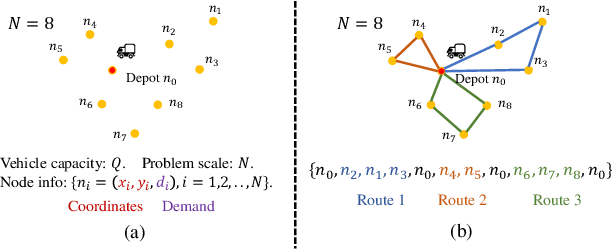
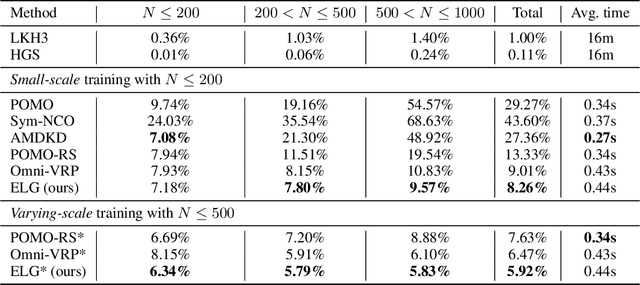
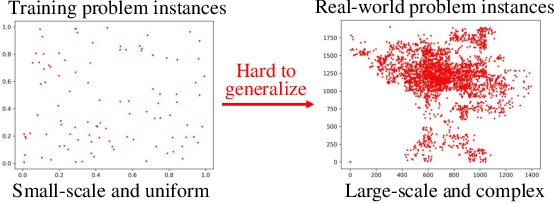

Abstract:Machine learning has been adapted to help solve NP-hard combinatorial optimization problems. One prevalent way is learning to construct solutions by deep neural networks, which has been receiving more and more attention due to the high efficiency and less requirement for expert knowledge. However, many neural construction methods for Vehicle Routing Problems (VRPs) focus on synthetic problem instances with limited scales and specified node distributions, leading to poor performance on real-world problems which usually involve large scales together with complex and unknown node distributions. To make neural VRP solvers more practical in real-world scenarios, we design an auxiliary policy that learns from the local transferable topological features, named local policy, and integrate it with a typical constructive policy (which learns from the global information of VRP instances) to form an ensemble policy. With joint training, the aggregated policies perform cooperatively and complementarily to boost generalization. The experimental results on two well-known benchmarks, TSPLIB and CVRPLIB, of travelling salesman problem and capacitated VRP show that the ensemble policy consistently achieves better generalization than state-of-the-art construction methods and even works well on real-world problems with several thousand nodes.
SegNetr: Rethinking the local-global interactions and skip connections in U-shaped networks
Jul 21, 2023Abstract:Recently, U-shaped networks have dominated the field of medical image segmentation due to their simple and easily tuned structure. However, existing U-shaped segmentation networks: 1) mostly focus on designing complex self-attention modules to compensate for the lack of long-term dependence based on convolution operation, which increases the overall number of parameters and computational complexity of the network; 2) simply fuse the features of encoder and decoder, ignoring the connection between their spatial locations. In this paper, we rethink the above problem and build a lightweight medical image segmentation network, called SegNetr. Specifically, we introduce a novel SegNetr block that can perform local-global interactions dynamically at any stage and with only linear complexity. At the same time, we design a general information retention skip connection (IRSC) to preserve the spatial location information of encoder features and achieve accurate fusion with the decoder features. We validate the effectiveness of SegNetr on four mainstream medical image segmentation datasets, with 59\% and 76\% fewer parameters and GFLOPs than vanilla U-Net, while achieving segmentation performance comparable to state-of-the-art methods. Notably, the components proposed in this paper can be applied to other U-shaped networks to improve their segmentation performance.
PL-Net: Progressive Learning Network for Medical Image Segmentation
Oct 27, 2021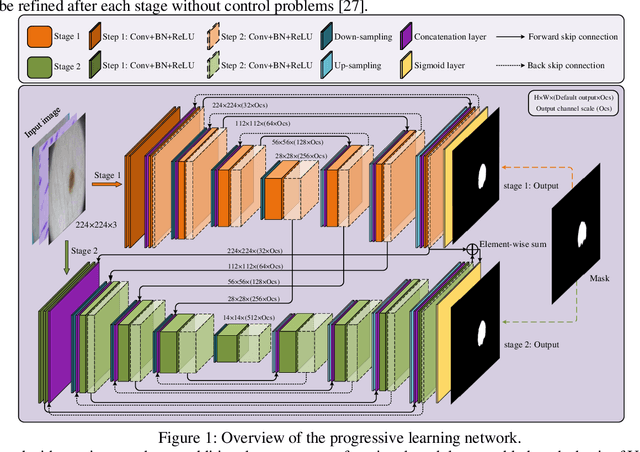
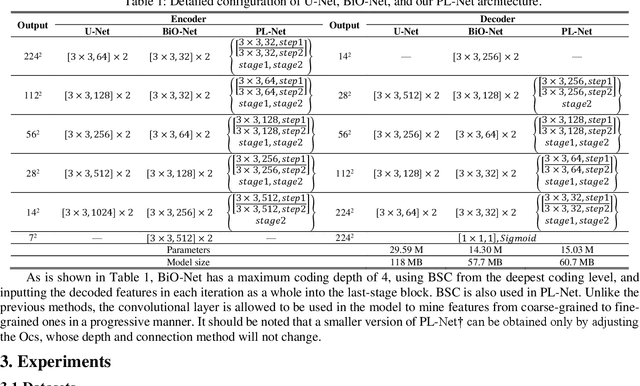
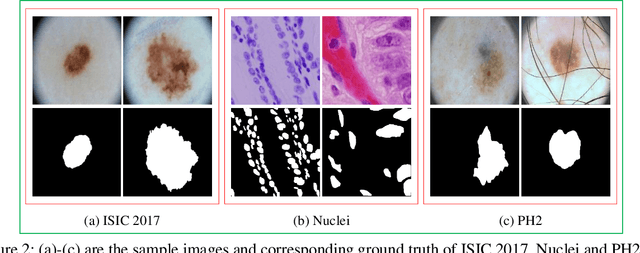
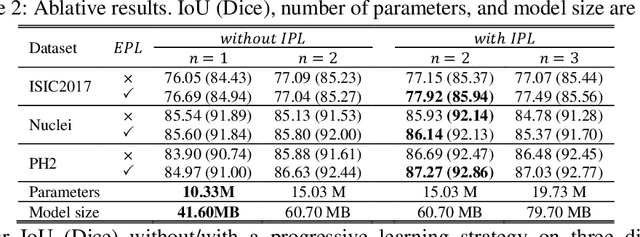
Abstract:In recent years, segmentation methods based on deep convolutional neural networks (CNNs) have made state-of-the-art achievements for many medical analysis tasks. However, most of these approaches improve performance by optimizing the structure or adding new functional modules of the U-Net, which ignoring the complementation and fusion of the coarse-grained and fine-grained semantic information. To solve the above problems, we propose a medical image segmentation framework called progressive learning network (PL-Net), which includes internal progressive learning (IPL) and external progressive learning (EPL). PL-Net has the following advantages: (1) IPL divides feature extraction into two "steps", which can mix different size receptive fields and capture semantic information from coarse to fine granularity without introducing additional parameters; (2) EPL divides the training process into two "stages" to optimize parameters, and realizes the fusion of coarse-grained information in the previous stage and fine-grained information in the latter stage. We evaluate our method in different medical image analysis tasks, and the results show that the segmentation performance of PL-Net is better than the state-of-the-art methods of U-Net and its variants.
 Add to Chrome
Add to Chrome Add to Firefox
Add to Firefox Add to Edge
Add to Edge